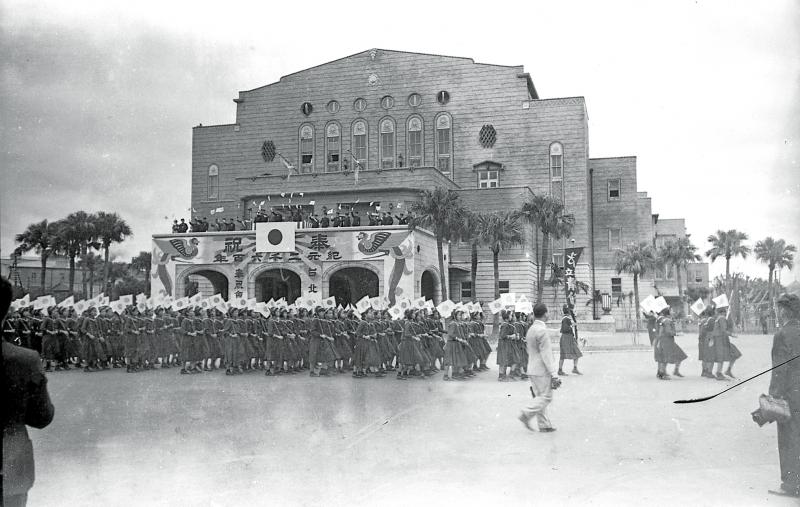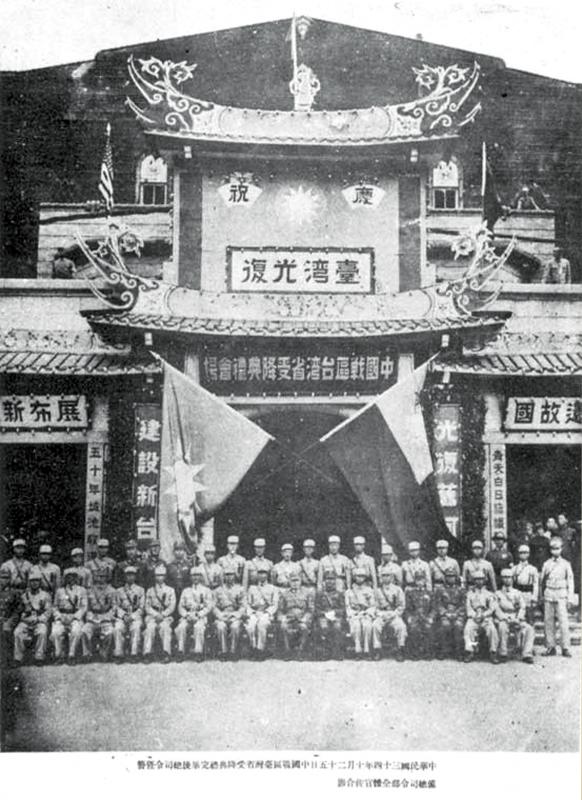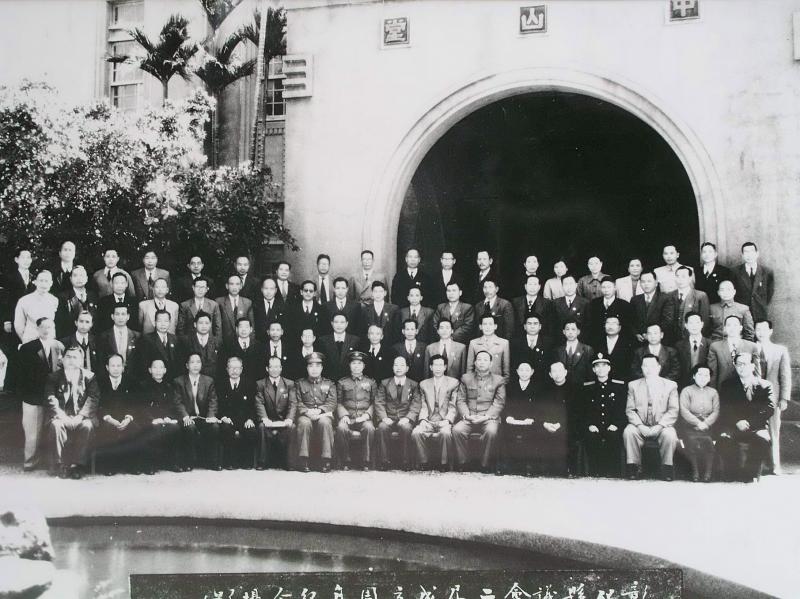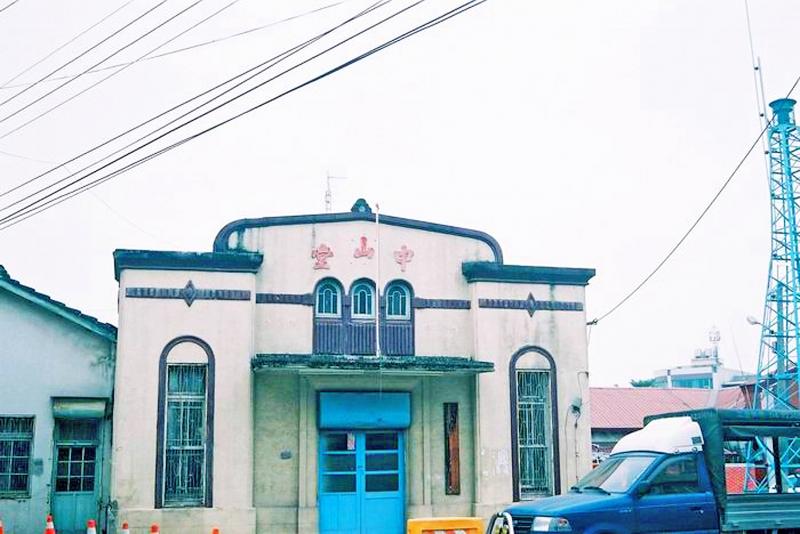Nov. 22 to Nov. 28
In Chu Tien-jen’s (朱點人) short story Autumn Letter (秋信), protagonist Dou Wen (斗文) arrives in Taipei in October 1935 and is shocked to see that a colossal, modern concrete building had replaced the Qing Dynasty Provincial Administration Hall.
Only the building’s exterior was complete, but it was enough to serve as the main exhibition space for the extravagant Taiwan Exhibition, held to showcase Japanese colonial achievements in Taiwan to the world.

Photo courtesy of Wikimedia Commons
Then-Fujian provincial governor Chen Yi (陳儀) was among the international guests for the exhibition as the Republic of China’s (ROC) representative, marveling at the displays and sending a detailed report to then-president Chiang Kai-shek (蔣介石). On Nov. 26, 1936, the building officially opened as the Taihoku Public Hall (台北公會堂).
Just over a decade after his first visit, Chen found himself in the structure again on Oct. 25, 1945, as he accepted Japan’s surrender to the Allies as Taiwan’s new governor-general under the Chinese Nationalist Party (KMT). The Taihoku Public Hall was built to honor the ascension of the Showa Emperor; the KMT renamed it Zhongshan Hall in honor of ROC founder Sun Yat-sen (孫逸仙).
This iconic Taipei landmark was just one of numerous Zhongshan Halls in Taiwan. Almost all Japanese-built public assembly halls across the nation were either demolished or given the same name after 1945. Wang Shao-chieh (王紹傑) counts 125 in his Study of Public Halls during the Japanese Colonial Period in Taiwan (台灣日治時期公會堂建築研究). But that’s not all, as assembly halls on military bases and state-owned factory complexes were also named Zhongshan Hall, as well as other governmental cultural spaces.

Photo courtesy of Wikimedia Commons
THE PUBLIC HALL
Wang writes that the Japanese erected these structures en masse to provide assembly space and rule more efficiently. They hosted events ranging from graduation ceremonies and weddings to business parties and government celebrations. The buildings also helped assert colonial authority and promote patriotism, especially after the late 1930s as Japanese imperialism grew.
Most of them had disappeared by the time Wang wrote the study; he counted only 10 standing in Taipei, Hsinchu, Dasi (大溪), Changhua (彰化), Lukang (鹿港), Ershui (二水), Douliu (斗六), Tainan, Sinhua (新化) and Hengchun (恆春).

Photo courtesy of Changhua County Cultural Affairs Bureau
The one Kirun (Keelung), for instance, was destroyed in an Allied air strike in 1945, while the Takao (Kaohsiung) Public Hall was demolished by the KMT to make way for a police station. Some lasted into the 1970s and 1980s, but they were razed before historical preservation became common.
Traditionally, Han Taiwanese communities conducted their public affairs in temples, and this type of assembly hall was unheard of before Japanese arrival. Whether they were funded by the government or local elites, these buildings often followed the trendiest styles and were impressive in both construction quality and size.
It’s debatable which public hall was the first in Taiwan, but the first one built according to the government-defined function was in Keelung, established in 1900 to celebrate the marriage of then-crown prince and future emperor Yoshihito. Wang, however, found an 1897 article that describes a business event at a public hall in Taipei’s Dadaocheng area, but notes that it was used almost exclusively for business purposes. Eighty-eight percent of the 125 public halls he lists were built between 1916 and 1936, with 14 completed in 1928 alone.

Photo: Yuan Yi-yu, Taipei Times
In August 1906, an editorial appeared in the Chinese version of the Taiwan Daily News (台灣日日新報) calling for a public hall in Taipei, as the one in Tamsui was about to be demolished. But due to funding issues, the project stalled. In 1925, Japanese politician and businessman Toshio Mimaki blasted the government for its lack of action, arguing that it was a travesty that a city the size of Taipei lacked a public hall. Public pressure mounted, and finally in 1927, the governor-general included the hall’s construction in its plans to celebrate the Showa Emperor’s ascension a year earlier.
Taipei Public Hall was to replace the Qing Dynasty Provincial Administration Hall, which served as the Governor-General’s Office until today’s Presidential Office Building was finished in 1919. An intense debate ensued on whether to preserve the classical Qing compound; only parts of it were saved and relocated to today’s Taipei Botanical Gardens.
POST-WAR YEARS

Photo: Huang Ming-tang, Taipei Times
Zhongshan Hall became a symbol of KMT authority after the war, starting from when a massive cheering crowd celebrated the end of colonial rule in its plaza on Oct. 25, 1945. But this jubilant mood soon soured, and in 1947 the infamous anti-government uprising known as the 228 Incident broke out.
In the following days, local politicians and intellectuals gathered at Zhongshan Hall and formed the 228 Incident Settlement Committee, hoping to reach a peaceful solution. Their efforts were futile, and the government brutally suppressed the unrest.
In the ensuing years, it was used as the National Assembly’s headquarters as well as a venue for important government functions such as national banquets, presidential swearing-in ceremonies and treaty signings. It also housed a number of foreign dignitaries. Many performances, public events and movie screenings were also held in Zhongshan Hall, including Cloud Gate Dance Theatre’s debut performance in 1973.
Writer Chiang Hsun (蔣勳) recalls frequenting the building for public performances with his mother as a young boy.
“When I was young, I didn’t feel anything special about the name Zhongshan Hall,” he writes in the 2002 book Return to Zhongshan Hall (返回中山堂). “I felt like there were Zhongshan Halls everywhere. It was one of those places where you could see a Peking Opera or watch a military song and dance performance; graduation ceremonies were held there and, during Youth Day or Retrocession Day, there would be grand events there.”
Chiang writes that although the site was a continuous symbol of authority under the Qing, Japanese and KMT, many who lived through those times mostly had fond memories of the cheerful and boisterous large-scale celebrations that happened here.
After the National Assembly moved to Yangmingshan, maintenance on the building fell off until the city launched a major restoration project in 1998. It reopened as a purely cultural and performance space in 2001.
Taiwan in Time, a column about Taiwan’s history that is published every Sunday, spotlights important or interesting events around the nation that either have anniversaries this week or are tied to current events.

This is the year that the demographic crisis will begin to impact people’s lives. This will create pressures on treatment and hiring of foreigners. Regardless of whatever technological breakthroughs happen, the real value will come from digesting and productively applying existing technologies in new and creative ways. INTRODUCING BASIC SERVICES BREAKDOWNS At some point soon, we will begin to witness a breakdown in basic services. Initially, it will be limited and sporadic, but the frequency and newsworthiness of the incidents will only continue to accelerate dramatically in the coming years. Here in central Taiwan, many basic services are severely understaffed, and

Jan. 5 to Jan. 11 Of the more than 3,000km of sugar railway that once criss-crossed central and southern Taiwan, just 16.1km remain in operation today. By the time Dafydd Fell began photographing the network in earnest in 1994, it was already well past its heyday. The system had been significantly cut back, leaving behind abandoned stations, rusting rolling stock and crumbling facilities. This reduction continued during the five years of his documentation, adding urgency to his task. As passenger services had already ceased by then, Fell had to wait for the sugarcane harvest season each year, which typically ran from

It is a soulful folk song, filled with feeling and history: A love-stricken young man tells God about his hopes and dreams of happiness. Generations of Uighurs, the Turkic ethnic minority in China’s Xinjiang region, have played it at parties and weddings. But today, if they download it, play it or share it online, they risk ending up in prison. Besh pede, a popular Uighur folk ballad, is among dozens of Uighur-language songs that have been deemed “problematic” by Xinjiang authorities, according to a recording of a meeting held by police and other local officials in the historic city of Kashgar in

It’s a good thing that 2025 is over. Yes, I fully expect we will look back on the year with nostalgia, once we have experienced this year and 2027. Traditionally at New Years much discourse is devoted to discussing what happened the previous year. Let’s have a look at what didn’t happen. Many bad things did not happen. The People’s Republic of China (PRC) did not attack Taiwan. We didn’t have a massive, destructive earthquake or drought. We didn’t have a major human pandemic. No widespread unemployment or other destructive social events. Nothing serious was done about Taiwan’s swelling birth rate catastrophe.